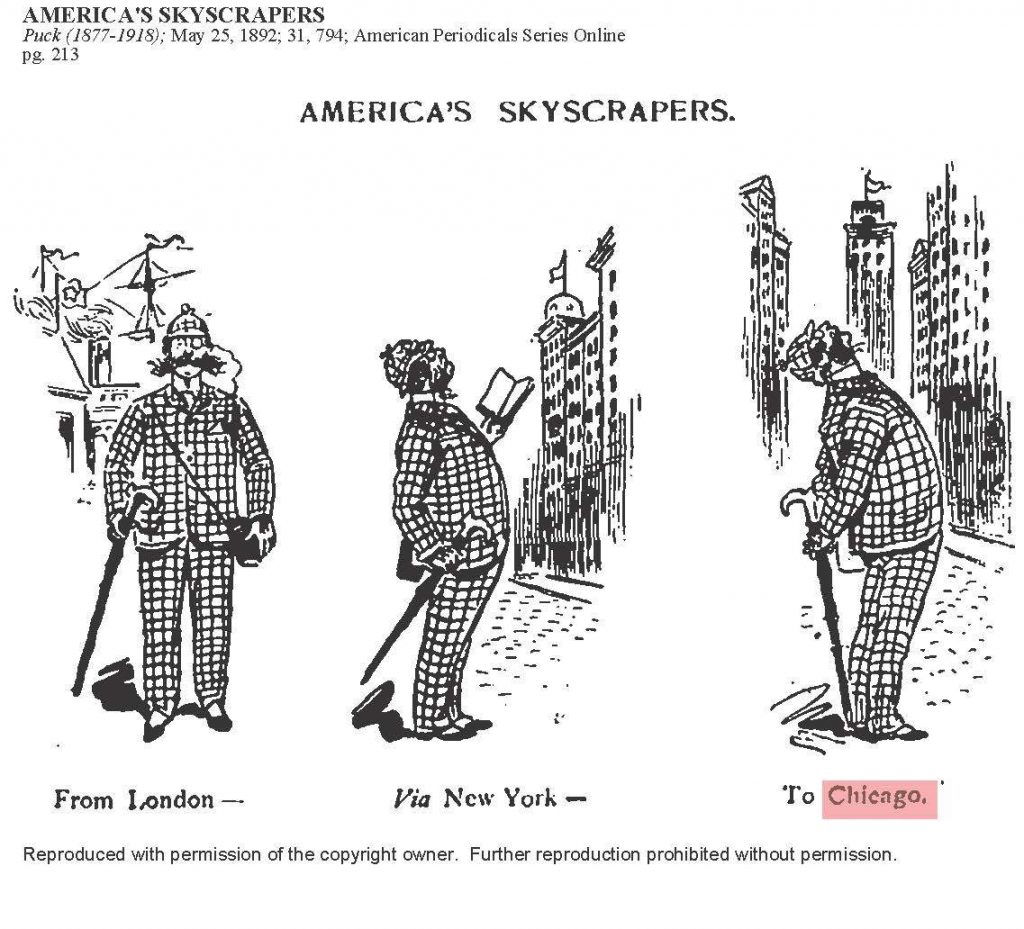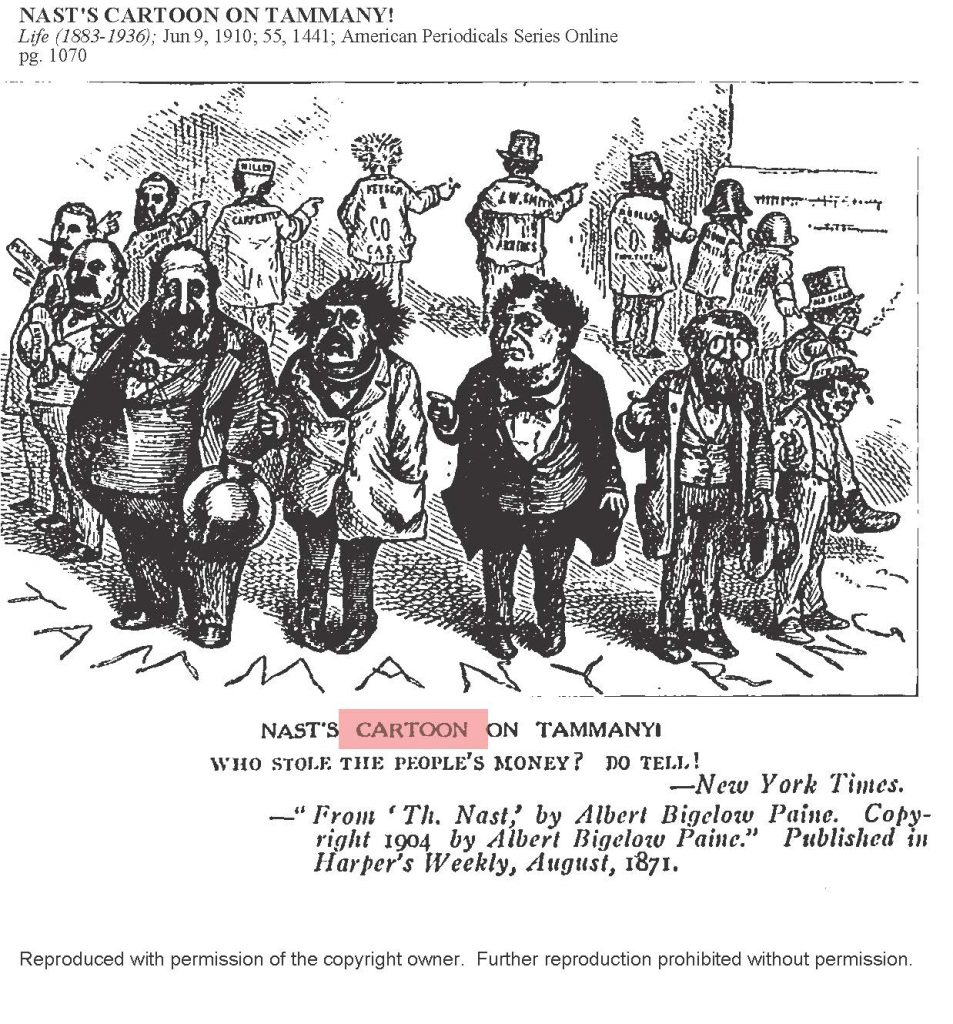CONTENT
- HOME PAGE
- PROLOGUE AN URBAN LEGACY
- INTRODUCING THE WEST SIDE
- 19th-CENTURY CAMERA
- URBAN PHOTOGRAPHERS HINE AND KIRKLAND
- PICTORIAL CHICAGO
- CHICAGO ENLIGHTENED CITY BEAUTIFUL
- CHICAGO GROTESQUE LAWLESS STREETS
- HULL-HOUSE "OASIS" IN A SLUM
- IMMIGRANT EMIGRANT CITY
- "ALIEN" COLONIES
- "RACE" COLONIES
- GHETTO LIVING
- "CHEAP" ECONOMY
- FAMILY
- AMUSEMENTS
- PUBLIC HEALTH
- TENEMENTS
- URBAN SOCIOLOGY CHICAGO SCHOOL
- MAXWELL STREET ARCHITECTURE TOUR
- CHICAGO CITY MAPS
POPULAR CARTOONS: CHICAGO
In U.S. magazines and newspapers in the later 19th century, editorial cartooning on politics and culture–local, national, international–became a popular comic art form. By means of a talented caricaturist and snappy caption, the target of the cartoon received instant recognition in the eyes of a gleeful beholder. A grandiose subject of current interest was diminished to grossly earthy dimensions through laughable humiliation and perverse mockery and ridicule.
Cartooning was perceived as retaliatory equal opportunity justice. The pompous, the vain, the greedy, the arrogant, the stupid and moronic, the different, the “other”–immigrants, Irish, Italians, Jews, Chinese, among others–received what audiences with their presumptions perceived as deserved derision for self-inflicted injury. Raw and unforgiving, cartooning democracy cultivated the “art of ill will.” Nothing and no person was sacred, immune from graphic scorn as a damned “fool”–a vain buffoon, maker of their own gullible foolishness.
In 1849, the moral lessons drawn in burlesque of failed speculators chasing the delusional dream of gold in California, risking the multiple death-defying perils of the journey, and returning poorer than when they left, caught the public’s imagination. Journey to the Gold Diggins by Jeremiah Saddlebags numbered among the first comic books in U.S. history in a culture war between “greenhorn” Argonauts walking to California and “naysayers” who denounced the chimera.
After the Civil War, The Phunny Man Mark Twain promoted learning by laughter when ridiculing the moralistic and didactic McGuffey Readers, and the false mythology of rewards earned by the “good” Christian boy and girl. Twain understood the comic potential of “naughty” Tom then Huck. He built the first great reading audience in American history. He knew about what he personally lectured: “Ah well, I am a great and sublime fool, but then I am God’s fool, and all his works must be contemplated with respect.”
Satirizing himself in advertisements for his lectures and writings with a protruding head and shock of disheveled electrified hair, audiences recognized Twain on-sight. He gave a palpable name to the income inequality, plutocracy, and corruption in The Gilded Age with its glittering veneer of an American prosperity masking the dross and dregs beneath of insatiable political avarice, greed, and dirty tricks. Self-serving politicians with their thieving hands in everyone’s pocket were poisonous.
“Stop them damned pictures” Boss Tweed of the Tammany Hall political machine is reported to have said after seeing Thomas Nast’s cartoon, “Who Stole the People’s Money.” “I don’t care so much what the papers say about me. My constituents can’t read. But damn it, they can see pictures.”
Three essential characteristics made for the successful magazine and newspaper cartoon presentation.
One, minimal reflection required. The ridiculed target was instantly recognized and the satirical message immediately understood abetted by brief captions. Well-intended do-gooders as well as stupid alien nationalities and bungling racial buffoons immediately became a threat to well-being.
Two, laughter, mirth, and humiliation, exposing the ludicrousness of vanity and self-righteous propaganda of an adversary were more effective weapons than historical physical confrontation, banishment, and dungeons. Cartooning was effectively combat by different means.
Three, a direct correlation between the numerical frequency of the appearance of a cartoon subject in print media and its importance in the immediate lives of the viewing audience. Political comedy fit in the vulgar American slang genre of “bullshit”–“money talks bullshit walks”–first appearing in the later nineteenth century, and prospering since.
Chicago was a rapidly expanding boastful city, center of the Midwest, with raw ambition in all things–the commerce of the 1893 World’s Fair; steel works, railroads, and skyscrapers; recent arrivals on the make; local political corruption and lawless districts. It’s largesse was ripe for graphic caricature. Visit Chicago and see the city, to be safe hire a 1905 prototype of a mechanized cavalry vehicle. The more things change it would seem the more they stay the same! bjb






